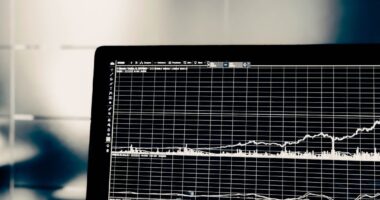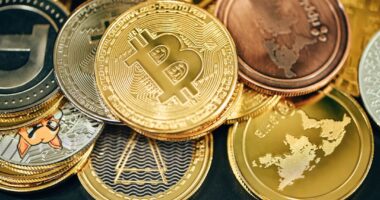Damien Hirst, a prominent British artist known for his provocative works, has recently entered the NFT (non-fungible token) market. NFTs are digital assets that use blockchain technology to verify ownership and authenticity of unique items or content. Hirst’s NFT collection, “The Currency,” comprises 10,000 distinct artworks, each paired with a corresponding NFT.
The collection features a diverse range of digital art, including detailed paintings and dynamic animations, all linked to individual NFTs on the Ethereum blockchain. Hirst’s venture into NFTs has generated significant interest and discussion within the art community. Some view it as an innovative approach that could transform the art market, while others express reservations about the implications of this digital transition.
Regardless of individual opinions, Hirst’s NFT collection has undeniably sparked renewed interest in the intersection of art and blockchain technology.
Key Takeaways
- Damien Hirst, a renowned artist, has recently entered the NFT space with a collection of digital art pieces.
- NFTs have revolutionized the art world by providing a new platform for artists to showcase and sell their work.
- Hirst’s exploration of digital art and NFTs marks a significant shift in his artistic practice and engagement with technology.
- Ethereum and Bitcoin play a crucial role in NFT transactions, providing the infrastructure for buying, selling, and trading digital art.
- NFTs have seen a rapid rise in the cryptocurrency market, attracting both art enthusiasts and investors.
The Impact of NFTs on the Art World
Empowering Artists and Democratizing the Art Market
The rise of NFTs has opened up new possibilities for artists to create and sell their work in a digital format, without worrying about issues of copyright infringement or unauthorized reproduction. Moreover, NFTs have democratized the art market by allowing artists to directly connect with collectors and enthusiasts from around the world, without the need for intermediaries such as galleries or auction houses.
Challenges and Concerns
However, the rise of NFTs has also raised questions about sustainability and environmental impact, as the process of minting NFTs on blockchain networks such as Ethereum requires a significant amount of energy. Additionally, there are concerns about the speculative nature of NFT trading, with some critics arguing that it has led to inflated prices and market volatility.
A New Era of Digital Creativity and Expression
Despite these challenges, it is clear that NFTs have fundamentally altered the way we perceive and engage with art, paving the way for a new era of digital creativity and expression.
Damien Hirst’s Exploration of Digital Art and NFTs

Damien Hirst’s decision to explore digital art and NFTs represents a bold departure from his previous body of work, which is primarily associated with physical sculptures, paintings, and installations. With “The Currency,” Hirst has embraced the potential of digital technology to push the boundaries of his artistic practice and reach a wider audience in the digital realm. The collection features a diverse range of artworks that showcase Hirst’s signature motifs and themes, reimagined in a digital format that is both captivating and immersive.
Hirst’s embrace of NFTs also reflects his interest in experimenting with new modes of artistic production and distribution. By leveraging blockchain technology, Hirst has created a platform for collectors to acquire and own exclusive digital artworks that are authenticated through a decentralized and tamper-proof system. This marks a significant shift in Hirst’s approach to art-making, as he embraces the possibilities offered by NFTs to redefine notions of scarcity, ownership, and value in the digital age.
Furthermore, Hirst’s exploration of NFTs has sparked conversations about the role of established artists in shaping the future of digital art and blockchain technology. As a prominent figure in the contemporary art world, Hirst’s foray into NFTs has brought attention to the potential for established artists to leverage their influence and reputation to drive innovation and experimentation in the digital art space. Whether one views Hirst’s venture into NFTs as a pioneering move or a controversial departure from his traditional practice, it is undeniable that it has sparked a new chapter in his artistic journey.
The Role of Ethereum and Bitcoin in NFT Transactions
| Metrics | Ethereum | Bitcoin |
|---|---|---|
| Transaction Speed | 15 transactions per second | 7 transactions per second |
| Gas Fees | Varies based on network congestion | Varies based on network congestion |
| Smart Contract Support | Native support for smart contracts | Limited smart contract support |
| Market Dominance | Majority of NFT transactions | Limited use in NFT transactions |
Ethereum and Bitcoin play a crucial role in facilitating NFT transactions, serving as the underlying blockchain networks that power the creation, trading, and ownership of non-fungible tokens. Ethereum, in particular, has emerged as the leading platform for minting and trading NFTs due to its robust smart contract capabilities and support for decentralized applications. Artists and creators can use Ethereum to mint their own NFTs, which are then stored on the blockchain and can be bought, sold, or traded on various online marketplaces.
Bitcoin, on the other hand, has also been involved in the NFT space, albeit to a lesser extent compared to Ethereum. While Bitcoin is primarily known as a store of value and medium of exchange, some artists and collectors have experimented with using Bitcoin as a means to buy and sell NFTs. However, due to Bitcoin’s limited scripting language and focus on security and decentralization, it is not as widely used for NFT transactions as Ethereum.
The integration of Ethereum and Bitcoin into the NFT ecosystem has not only provided a secure and transparent infrastructure for digital asset ownership but has also contributed to the growing mainstream adoption of blockchain technology in the art world. As more artists and collectors embrace NFTs as a legitimate form of artistic expression and investment, Ethereum and Bitcoin are likely to continue playing a pivotal role in shaping the future of digital art and tokenized assets.
The Rise of NFTs in the Cryptocurrency Market
The rise of NFTs has coincided with the growing popularity of cryptocurrencies, leading to an unprecedented convergence between digital art and blockchain-based assets. Cryptocurrencies such as Bitcoin and Ethereum have provided the financial infrastructure for buying, selling, and investing in NFTs, creating new opportunities for artists, collectors, and speculators alike. This has led to a surge in interest in NFTs within the cryptocurrency market, with many investors diversifying their portfolios to include digital assets alongside traditional cryptocurrencies.
Furthermore, the rise of NFTs has given rise to new decentralized platforms and marketplaces that specialize in curating and trading digital art. These platforms leverage blockchain technology to provide a secure and transparent environment for artists to showcase their work and for collectors to discover and acquire unique NFTs. As a result, NFTs have become an integral part of the broader cryptocurrency market, offering a novel avenue for individuals to engage with art as both a form of cultural expression and an investment opportunity.
However, the intersection of NFTs and cryptocurrencies has also raised concerns about market speculation and price volatility. The rapid rise in demand for NFTs has led to inflated prices for certain artworks, prompting debates about the sustainability and long-term viability of this emerging market. Additionally, there are ongoing discussions about the regulatory implications of NFT trading within the cryptocurrency space, as authorities seek to establish guidelines for protecting investors and ensuring market integrity.
Despite these challenges, it is evident that NFTs have become an influential force within the cryptocurrency market, reshaping how we perceive value and ownership in the digital age.
Criticisms and Controversies Surrounding Damien Hirst’s NFT Collection

The Commodification of Art
Critics argue that Hirst’s foray into NFTs marks a departure from his traditional artistic practice, risking the dilution of his artistic legacy. They contend that the speculative trading of NFTs contributes to the commodification of art, undermining its cultural value.
Environmental and Authenticity Concerns
The environmental impact of minting NFTs on blockchain networks has raised concerns about the carbon footprint associated with NFT production. Furthermore, instances of plagiarism and copyright infringement have led to questions about the authenticity and provenance of digital artworks.
The Democratization of Art
Despite these criticisms, Hirst’s NFT collection has also sparked conversations about the democratization of art ownership and access through blockchain technology. By leveraging NFTs, Hirst has created a platform for individuals to directly engage with his work in a digital format, bypassing traditional gatekeepers such as galleries or auction houses. This has led to debates about the potential for NFTs to redefine how we perceive art as a form of cultural expression and economic value.
The Future of NFTs and Digital Art in the Art World
The future of NFTs and digital art in the art world is poised for continued growth and evolution as artists, collectors, and technologists explore new possibilities for creative expression and ownership. The intersection of blockchain technology with art has opened up avenues for artists to experiment with new mediums and formats that transcend traditional boundaries. This has led to an influx of innovative digital artworks that challenge our perceptions of what constitutes art in the 21st century.
Furthermore, as more artists embrace NFTs as a legitimate form of artistic expression, we are likely to see greater diversity in terms of style, subject matter, and cultural representation within the digital art space. This democratization of artistic production has the potential to foster greater inclusivity within the art world by providing opportunities for underrepresented voices to be heard and celebrated. However, as NFTs continue to gain traction within the art world, it will be essential for stakeholders to address ongoing concerns about sustainability, authenticity, and market speculation.
Efforts to mitigate the environmental impact of blockchain technology through energy-efficient solutions will be crucial in ensuring the long-term viability of NFT production. Additionally, establishing robust mechanisms for verifying the authenticity and provenance of digital artworks will be essential for maintaining trust and integrity within the NFT market. In conclusion, Damien Hirst’s exploration of NFTs represents a pivotal moment in the ongoing dialogue about the future of art in the digital age.
As artists continue to push boundaries and experiment with new technologies, we can expect to see an exciting convergence between traditional artistic practices and emerging digital mediums. The potential for NFTs to redefine how we perceive value and ownership in art holds promise for a more inclusive and dynamic art world that embraces innovation while upholding principles of authenticity and cultural significance.
FAQs
What is an NFT?
An NFT, or non-fungible token, is a digital asset that represents ownership or proof of authenticity of a unique item or piece of content, such as artwork, videos, or music, using blockchain technology.
Who is Damien Hirst?
Damien Hirst is a renowned British artist known for his controversial and thought-provoking works, including his famous series of preserved animals and pharmaceutical-themed artworks. He is considered one of the most prominent artists of the Young British Artists (YBAs) movement.
What is Damien Hirst’s involvement in NFTs?
Damien Hirst made headlines by announcing his foray into the world of NFTs with a collection titled “The Currency.” This collection features 10,000 unique artworks, each corresponding to a unique NFT, and marks Hirst’s first major venture into digital art and collectibles.
Why is Damien Hirst’s NFT collection significant?
Damien Hirst’s entry into the NFT space is significant because it represents a major milestone for traditional artists embracing digital platforms and blockchain technology. It also signals a shift in the art world’s acceptance and adoption of NFTs as a legitimate medium for artistic expression and ownership.
How can one acquire Damien Hirst’s NFT collection?
The “The Currency” collection was made available for purchase through the Palm platform, where collectors could acquire the digital artworks using cryptocurrency. Each NFT corresponds to a unique digital artwork created by Hirst, and ownership is recorded on the blockchain.





